Ten years have passed since Russia’s winter protests of 2012. They began as demonstrations opposing voter fraud in the 2011 State Duma elections, and segued into rallies against the now-infamous “castling” that returned Vladimir Putin to the presidency. Indeed, large-scale opposition protests formed the backdrop of Putin’s 2012 presidential campaign. Looking back, it seems as though this was the last time that both the Russian authorities and their opponents were equally and seriously engaged in politics on the streets of Moscow. On the tenth anniversary of the protests, Meduza looks back at how this political struggle played out.
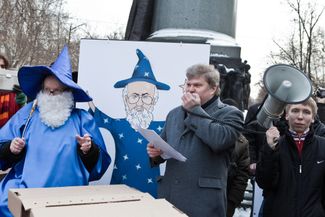
The Yabloko party held a sanctioned rally opposing voter fraud in the December 2011 State Duma elections at Chistye Prudy on January 4, 2012. The most striking participant was an opposition activist dressed in a wizard costume, who was meant to represent the Central Election Commission’s then-chairman Vladimir Churov. Next to him in the photo is Yabloko party leader Sergey Mitrokhin. Several hundred people attended the rally.
Evgeny Feldman
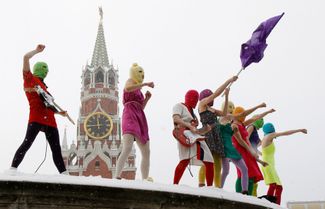
On January 20, Pussy Riot performed on Moscow’s Red Square. They sang their song “Putin has Pissed Himself” while standing on the Lobnoye Mesto platform, which was once where royal decrees were announced and public executions were held. The Pussy Riot members were later detained by police, but they were released by evening.
Denis Sinyakov / Reuters / Scanpix / LETA

A woman waves a white sheet of paper and a white ribbon at drivers on Moscow’s Garden Ring. This photo was taken on January 29. At the time, hundreds of cars with white ribbons or white balloons were circling the Garden Ring in a show of support for the protesters.
Mikhail Mettsel / AP / Scanpix LETA
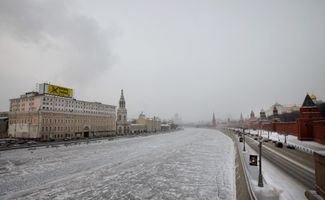
On February 1, members of the Solidarity movement, led by Ilya Yashin, set up a giant yellow billboard with the words “Putin, leave!” on a building across the river from the Kremlin.
Alexander Zemlyanichenko / AP / Scanpix / LETA

On February 3, activists from Street Art Resistance organized an action in the Moscow subway called “Try to Go Higher.” They went from station to station with posters attached to bouquets of white balloons and urged people to join a march for fair elections scheduled for the next day.
Evgeny Feldman

On February 4, one month before the presidential elections, tens of thousands of people took to the icy streets of Moscow to demand that Vladimir Putin resign from his post as prime minister and refrain from putting his name on the ballot in the upcoming vote.
Alexander Zemlyanichenko Jr. / AP / Scanpix / LETA

Many attended the rallies in costumes. Sometimes, this led to absurd situations. For example, at a protest on Bolotnaya Square, opposition figure Alexey Navalny had his photo taken with members of the youth movement Rossiya Molodaya (Young Russia) who were wearing hamster costumes. At the time, pro-Kremlin activists had started referring to Navalny’s supporters as hamsters.
Scanpix / LETA

A group of Airborne Forces veterans performing at a protest on February 4. Their anti-Putin protest song became an instant hit.
Ivan Sekretarev / AP / Scanpix / LETA
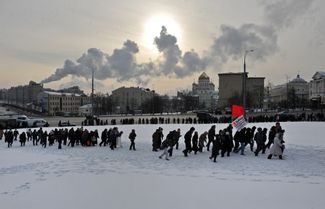
According to the rally’s organizers, up to 120,000 people took part in the protest on February 4, despite the fact that it was -20 degrees Celsius (-4 degree Fahrenheit) outside. It was the largest rally of that winter.
Artyom Zhitenev / Scanpix / LETA
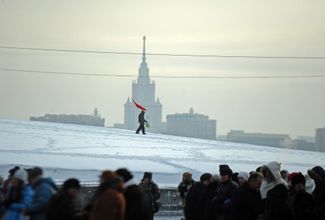
To counter the protest on Bolotnaya Square, the authorities decided to hold their own rally on Poklonnaya Hill on February 4. According to various estimates, between 35,000 and 138,000 people took part in the demonstration, which was called “We Have Something to Lose.” Buses carrying demonstrators arrived at Poklonnaya Hill right on time for the rally. These pro-government demonstrations became known as “Putings” — a combination of the surname “Putin” and the Russian word “miting” (which means rally).
Maxim Novikov / TASS
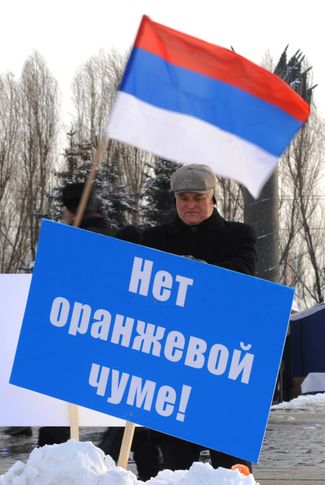
The main theme of the rally on Poklonnaya Hill was the alleged threat of a “color revolution.”
Scanpix / LETA

The organizer of the rally, political scientist Sergey Kurginyan, gave an impassioned speech, proclaiming: “We say ‘no’ to the destruction of Russia!”
Scanpix / LETA
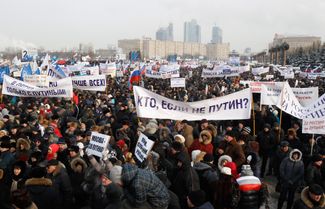
Many of those who gathered on Poklonnaya Hill wore Russian Post, Transaero, or Moscow Utility Service uniforms. Demonstrators admitted to journalists that they hadn’t come to the rally of their own volition, while also assuring that they supported Putin. At the end of the rally, the police wanted to fine the organizers for exceeding the number of sanctioned participants (they had applied for a 15,000-person rally). In response, Vladimir Putin volunteered to pay the fine.
Sergey Karpukhin / Reuters / Scanpix / LETA

On February 7, Central Election Commission head Vladimir Churov held a master class for photojournalists. With the correct technique, Churov asserted, it’s possible to take real, artistic snapshots at polling stations, and not just document the voting process.
Denis Sinyakov / Reuters / Scanpix / LETA
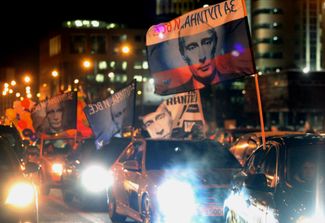
On February 18, a rally in support of Vladimir Putin took place in Moscow. Each car flew a flag with the then-presidential candidate’s portrait.
AFP / Scanpix / LETA
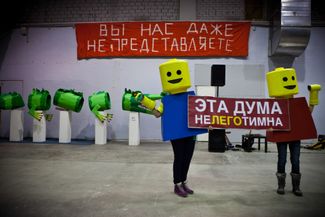
On February 20, an exhibition of protest art titled “You Don’t Even Represent Us” opened at Artplay — the most democratic art platform in Moscow in the early 2010s. Nearly all of the posters on display had appeared at that winter’s protests. The people in Lego costumes, for example, carried a sign with the slogan “This Duma is Illegitimate” (deliberately misspelled to include the word “Lego”) down Sakharov Avenue.
Evgeny Feldman

On February 20, President Dmitry Medvedev met with the leaders of unregistered opposition parties at his official Gorky residence outside Moscow. The meeting included the likes of Boris Nemtsov, Sergey Udaltsov, and Vladimir Ryzhkov, among others. They discussed the possibility of simplifying the rules for registering political parties, along with other issues that the opposition had raised during the protests earlier in the month. “Our political system is far from ideal,” Medvedev conceded.
Reuters / Scanpix / LETA

Against the backdrop of the massive opposition protests, Putin did his best to run an active election campaign. On February 22, he and then-Defense Minister Anatoly Serdyukov paid a visit to the Tamanskaya Motor Rifle Division in the village of Kalininets near Moscow.
Alexey Nikolsky / AFP / Scanpix / LETA

Billboards sporting Putin’s election campaign posters could be found throughout the country. This particular billboard reads: “A great country — a dignified future!” It was photographed in Smolensk on March 2, two days before the elections.
Viktor Drachev / AFP / Scanpix / LETA
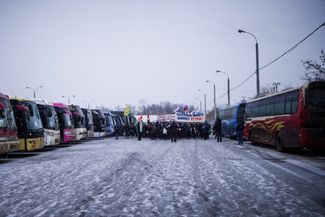
On February 23, pro-Kremlin rallies began in Moscow once again. Unlike the one on Poklonnaya Hill, which was presented as a gathering of opponents of the opposition, these new rallies were focused on Putin specifically. This was the first time the ruling United Russia party bussed in people from the regions to take part in public events in support of Putin.
Evgeny Feldman

Tens of thousands of people took part in a pro-Putin march on February 23. They walked along the Frunzenskaya Embankment to Luzhniki Stadium, where they listened to Putin give a campaign speech.
Sasha Mordovets / Getty Images
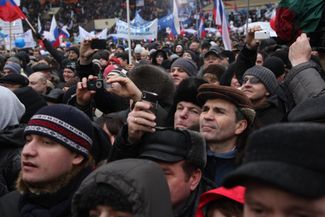
A crowd of Putin supporters — made up of Muscovites and those who were brought in on the many buses from the regions — gathered at Luzhniki Stadium.
Sasha Mordovets / Getty Images

The authorities managed to fill Luzhniki Stadium, but near the end of the event, a number of people started to leave. Therefore, Putin had to finish giving his speech in front of a half-empty stadium. He spoke about his love for Russia, saying that the battle for the country was ongoing. At the very end of his speech he recited an excerpt from Mikhail Lermontov’s poem “Borodino.”
Evgeny Feldman
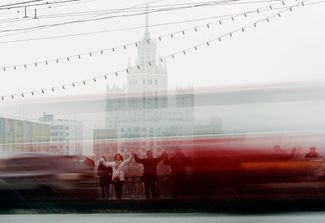
On February 26, opposition supporters staged yet another rally in Moscow. It was called the “White Ring” protest: thousands of people took to the Garden Ring and, holding each other’s hands, formed a circle around the city center.
Denis Sinyakov / Reuters / Scanpix / LETA

Opposition politician Boris Nemtsov taking part in the “White Ring” protest
Evgeny Feldman

Drivers and passengers in taxis traveling along the Garden Ring rolled down their windows to show support for the protesters
Evgeny Feldman
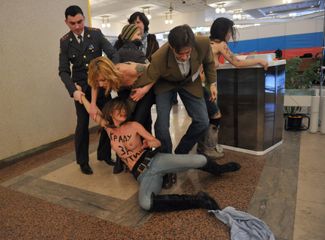
On March 4, three activists from the Ukrainian women’s rights group FEMEN showed up at the Moscow polling station where, shortly beforehand, Vladimir Putin had cast his ballot. They went right up to the ballot boxes, took off their shirts to reveal slogans written across their torsos (such as “I Steal for Putin!”), and began chanting the protest slogan “Putin is a thief!”. They were detained by security immediately.
Scanpix / LETA
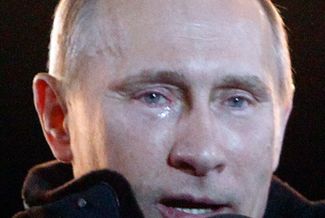
Immediately after voting closed on the evening of March 4, a pro-Putin rally took place on Moscow’s Manezh Square. The president-elect addressed the crowd with tears in his eyes. Later, Kremlin spokesman Dmitry Peskov said that Putin’s eyes were watering from the wind.
Mikhail Voskresensky / Reuters / Scanpix / LETA
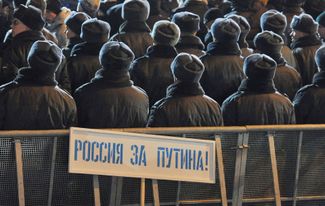
In addition to speeches by Putin and Medvedev, city residents and law enforcement officers gathered on Manezh Square were treated to a concert.
Vasily Shaposhnikov / Kommersant
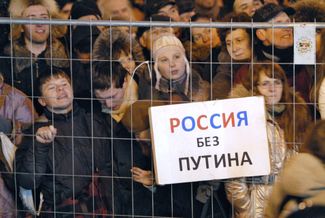
The day after the presidential vote, on March 5, opposition supporters flocked to Pushkin Square.
Maxim Polyakov / Kommersant

Around 15,000 people attended the peaceful demonstration on Pushkin Square. It was led by the co-chairman of the People’s Freedom Party Vladimir Ryzhkov, journalist Tatyana Lazareva, and opposition figure Anastasia Udaltsova. “We will achieve a peaceful transition from a rotten dictatorship to a normal, democratic state,” politician Ilya Yashin said at the rally. “Russia is us.”
Scanpix / LETA
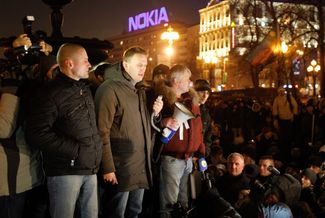
Oligarch Mikhail Prokhorov, who lost the election, addressed the crowd: “I will fight for a free country where our citizens will vote not out of fear, but out of dignity.” Then, Alexey Navalny spoke: “Yesterday was a hard day. What, did you expect anything else?”. During the speeches, riot police with shields surrounded Pushkin Square. After Vladimir Ryzhkov announced the end of the rally, Left Front leader Sergey Udaltsov urged people not to leave the square. The police began to disperse the remaining protesters.
Denis Sinyakov / Reuters / Scanpix / LETA

Riot police carried out violent arrests on Pushkin Square, dragging people into police vans. Around midnight, the Interior Ministry reported that in total, approximately 250 people had been detained after the rallies in Moscow. Alexey Navalny, Sergey Udaltsov, and Ilya Yashin were among the detainees. All the detainees were released soon afterward.
Thomas Peter / Reuters / Scanpix / LETA
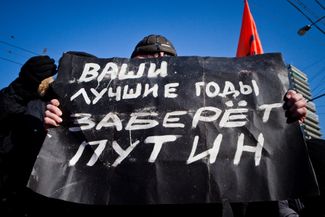
The last rally in the series of winter protests in 2012 took place on Novy Arbat Avenue on March 10. The demonstration drew almost as many people as the rally on Pushkin Square on March 5 , but people seemed to have “cooled off.” Sergey Udaltsov and his supporters attempted to organize an unsanctioned march, but they were detained immediately.
Evgeny Feldman
Photo editor — Evgeny Feldman
Translation — Eilish Hart
Bagikan Berita Ini

















0 Response to "Remembering the winter of protests - Meduza"
Post a Comment